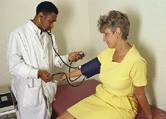
THURSDAY, July 31, 2014 (HealthDay News) — A new report finds that by 2010, one in every 10 visits Americans made to their doctor’s office involved diabetes, with the greatest rise among those aged 25 to 44.
Data from the U.S. Centers for Disease Control and Prevention found the number of office visits for patients with diabetes in this age group jumped by 34 percent between 2005 and 2010.
Almost 29 million Americans have diabetes, the CDC said, and managing the blood sugar disease costs almost $245 billion each year. Diabetes falls into two categories: Type 1, which is typically inherited and comprises about 5 percent of cases, and type 2, which is closely tied to obesity and makes up 95 percent of cases.
Overall, the new report from the CDC’s National Center for Health Statistics (NCHS) found that office-based visits for diabetes patients rose by 20 percent — from 94.4 million in 2005 to 113.3 million in 2010.
Since diabetes is linked to other conditions such as heart disease, vision trouble and stroke, many of these visits involved treatment for multiple problems, the report found.
One expert wasn’t surprised.
“Eighty-seven percent of visits to physicians by patients with diabetes were made by patients with multiple chronic conditions,” said Dr. Jeffrey Powell, chief of the division of endocrinology at Northern Westchester Hospital in Mt. Kisco, N.Y.
“Approximately 35 percent of visits made by patients age 45 and over were by patients with four or more chronic conditions,” he added. “This means that in addition to addressing diabetes, physicians have to consider multiple other medical conditions that the patients have as well. This becomes difficult to do in one office visit.”
The CDC report, published July 31 in the NCHS Data Brief, also found that treatment got more complicated as people aged.
“Five or more drugs were continued or prescribed at 60 percent of the visits by patients with diabetes age 65 and over,” Powell said. “This suggests that as people with diabetes get older, they have to take multiple medications. There is a significant financial burden to patients, plus this ‘polypharmacy’ can increase the chance that all of the medications will not be taken exactly as prescribed.”
Another expert was alarmed by the findings in the young adult age group.
The new report “demonstrates that diabetes is no longer a disease of older patients,” said Dr. Alyson Myers, an endocrinologist at North Shore University Hospital in Manhasset, N.Y.
Type 2 diabetes has “become prevalent in adolescence with the ongoing obesity epidemic,” she noted.
Myers also said it was “unsurprising to note that older patients have the greatest volume of visits,” since they often have multiple chronic conditions. These may include high blood pressure, kidney trouble, high cholesterol levels and heart disease.
More information
Learn more about diabetes at the American Diabetes Association.
Copyright © 2025 HealthDay. All rights reserved.

